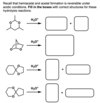Organic Chemistry - TPR Review Questions Flashcards
Explain the difference between sigmaandpi bonds
Sigma: single bonds (result of end-to-end overlap of orbitals)
Pi: double bonds and triple bonds (result of side-to-side overlap of orbitals)

Explain the difference between sp-, sp2-, and sp3-hybridized carbon atoms
sp-
two groups bonded 180 degrees apart
sp2-
three groups bonded 120 degrees apart
sp3-
four groups bonded 109.5 degrees apart

Name three functional groups that have delocalized electrons
All carbonyl containing groups:

Ester
Amide
Carboxylic Acid
Acid Anhydride
Acid Halide
Aldehyde
Ketone
To what term does unsaturated refer to
An unsaturated molecule contains one or more rings or a pi bond resulting in less than maximum hydrogens
Rank the four possible types of alky carbocations from least stable to most stable:
(least)
Unsubstituted (methyl)
Primary
Secondary
Tertiary
(most)

What must be present for resonance to occur?
A pi bond so that electrons can be delocalized
What is a chiral center?
A carbon atom bearing 4 different substituents
Explain the difference between:
structural isomers
conformational isomers
stereoisomers
structural isomers
two molecules with same molecular formula but different connectivities
conformational isomers
same molecular formula but differ in rotations about single bond
stereoisomers
same molecular formula, same connectivities, but groups differ in spacial arrrangements in molecule

What is a different name for geometric isomers?
Geometric isomers are a type of diastereomer. They can also be referred to as cis/trans isomers about a double bond or ring.

What are the two types of stereoisomers?
What are the differences?
geometric isomers
optical isomers

What is the most stable conformation of methylcyclohexane?
The chair form with an equatorial methyl group

What is a racemic mixture?
A mixture of enantiomers that are in equal proportions (50/50) and thus do not reflect plane polarized light (no optical activity)
What is a nucleophile?
What is an electrophile?
A nucleophile is a species that is electron rich and is attracted to something that is electron deficient to donate a pair of electrons to. It usually has either a full or a partial negative charge associated with it and/or a lone pair of electrons.
An electrophile is a species that is electron deficient, so it is attracted to an electron rich species. It usually has either a full or partial positive charge associated with it.
What is a Lewis Acid?
What is a Lewis Base?
A Lewis Acid is an electron-pair acceptor (or an electrophile)
A Lewis Base is an electron-pair donor (or a nucleophile)
What is a leaving group? What makes something a good leaving group?
A leaving group is a stable species that detaches itself from a molecule with its electron pair during the course of a reaction

Is inversion of configuration seen in an SN1 or an SN2 reaction? Which yields a racemic mixture of products?
An inversion of configuration is seen in an SN2 reaction; and an SN1 reaction yields a racemic mixture
Why?


























